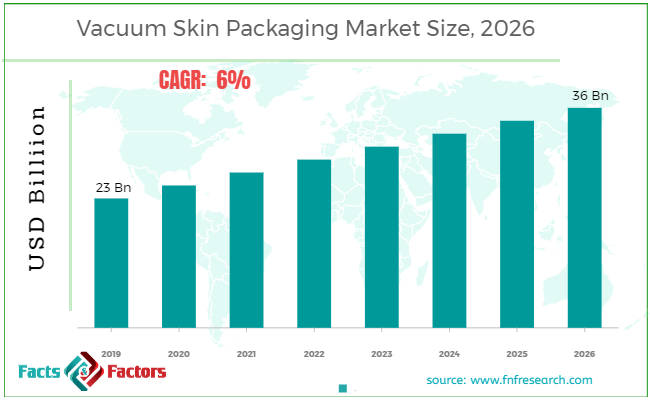Search Market Research Report
Vacuum Skin Packaging Market Size, Share Global Analysis Report, 2020–2026

Vacuum Skin Packaging Market By Material Type (Polyethylene (PE), Polypropylene (PP), Polyvinyl Chloride (PVC) and others), By Application (Meat, Poultry, Cheese, And Others), By Product Type (Vacuum Trays And Vacuum Bag): Global Industry Outlook, Market Size, Business Intelligence, Consumer Preferences, Statistical Surveys, Comprehensive Analysis, Historical Developments, Current Trends, and Forecast 2020–2026
Industry Insights
[189+ Pages Report] According to the report published by Facts Factors, the global vacuum skin packaging market size was worth around USD 23 billion in 2019 and is predicted to grow to around USD 36 billion by 2026 with a compound annual growth rate (CAGR) of roughly 6% between 2023 and 2030. The report analyzes the global vacuum skin packaging market drivers, restraints/challenges, and the effect they have on the demands during the projection period. In addition, the report explores emerging opportunities in the vacuum skin packaging market.
The vacuum skin packaging market report analyzes and notifies the industry statistics at the global as well as regional and country levels in order to acquire a thorough perspective of the entire vacuum skin packaging market. The historical and past insights are provided for FY 2016 to FY 2019 whereas projected trends are delivered for FY 2020 to FY 2026. The quantitative and numerical data is represented in terms of both volume (Kilotons) and value (USD Million) from FY 2016 – 2026.

 Key Insights from Primary Research
Key Insights from Primary Research
- According to the primary CXOs of the global vacuum skin packaging market, the market is estimated to witness a substantial growth of nearly 6% over the forecast period.
- The market was valued at USD 23 billion, in 2019 and is expected to be valued at over USD 36 billion.
- By material type segmentation, the polyethylene (PE) category is expected to contribute the largest market share in the global vacuum skin packaging market owing to its features. Polyethylene does not react with food; it is strong and able to resist the micro-organism attack and due to this feature it is approved by health safety organizations.
- On the basis of the application segment, the meat category led the market in 2019 and it is anticipated to grow in the future years attributed of the rising number of meat consumers. Meat is a rich source of protein and consumes as food by humans.
- By product type segment, the vacuum bag category held the largest market share in 2019, and it is projected to be the largest growing segment over the forecast period. A vacuum bag protects the food from air contact and keeps it moisturized. It takes up small storage space.
 Key Recommendations from Analysts
Key Recommendations from Analysts
- According to our analysts, North America is expected to dominate the market for vacuum skin packaging owing to increasing technological advancement in vacuum packaging and increasing demand for meat and other seafood.
- Owing to the growing urbanization and increasing disposable income, changing lifestyles and preferences, the Asia Pacific region is anticipated to boost the market in the future years.
- Europe is expected to witness significant growth in the vacuum skin packaging market.
- Due to the increasing demand for cheese products, the cheese category is estimated to enhance the market growth during the period 2020-2026.
- Owing to technological innovations and increasing demand for a packed food products in emerging countries may produce beneficial opportunities in the market.
The quantitative data is further underlined and reinforced by comprehensive qualitative data which comprises various across-the-board market dynamics. The rationales which directly or indirectly impact the vacuum skin packaging industry are exemplified through parameters such as growth drivers, restraints, challenges, and opportunities among other impacting factors.
Throughout our research report, we have encompassed all the proven models and tools of industry analysis and extensively illustrated all the key business strategies and business models adopted in the vacuum skin packaging industry. The report provides an all-inclusive and detailed competitive landscape prevalent in the vacuum skin packaging market.
The report utilizes established industry analysis tools and models such as Porter’s Five Forces framework to analyze and recognize critical business strategies adopted by various stakeholders involved in the entire value chain of the vacuum skin packaging industry. The vacuum skin packaging market report additionally employs SWOT analysis and PESTLE analysis models for further in-depth analysis.
The report study further includes an in-depth analysis of industry players' market shares and provides an overview of leading players' market position in the vacuum skin packaging sector. Key strategic developments in the vacuum skin packaging market competitive landscape such as acquisitions & mergers, inaugurations of different products and services, partnerships & joint ventures, MoU agreements, VC & funding activities, R&D activities, and geographic expansion among other noteworthy activities by key players of the vacuum skin packaging market are appropriately highlighted in the report.
The vacuum skin packaging market research report delivers an acute valuation and taxonomy of the vacuum skin packaging industry by practically splitting the market on the basis of different types, categories, and regions. Through the analysis of the historical and projected trends, all the segments and sub-segments were evaluated through the bottom-up approach, and different market sizes have been projected for FY 2020 to FY 2026.
 Report Scope
Report Scope
Report Attribute |
Details |
Market Size in 2019 |
USD 23 Billion |
Projected Market Size in 2026 |
USD 36 Billion |
CAGR Growth Rate |
6% CAGR |
Base Year |
2019 |
Forecast Years |
2020-2026 |
Key Market Players |
DuPont, Amcor Limited, Sealed Air, Berry Global Inc., LINPAC Packaging Limited, Bemis Company Inc., G. Mondini SA, Green Packaging Material (Jiangyin) Co. Ltd., Plastopil Hazorea Company Ltd., and Others |
Key Segment |
By Material, Application, Product, and Region |
Major Regions Covered |
North America, Europe, Asia Pacific, Latin America, and the Middle East & Africa |
Purchase Options |
Request customized purchase options to meet your research needs. Explore purchase options |
The regional segmentation of the vacuum skin packaging industry includes the complete classification of all the major continents including North America, Latin America, Europe, Asia Pacific, and the Middle East & Africa. Further, country-wise data for the vacuum skin packaging industry is provided for the leading economies of the world.
Vacuum skin packaging is mainly used for the packaging of fresh consumables, in particular fish, meat, and other sea items. Vacuum skin packaging is used to improve product lifespan. The vacuum skin packaging eliminates the need for preservatives and provides clear packaging. The benefits of packaging vacuum skin include product recognition, and product safety during transport. Packing vacuum skin reduces food wastage and leakage changes. It supports food safety for longer periods of time.
The vacuum skin packaging makes the product clear to the customer so that customers can also determine the food quality. It also reduces the cost of maintenance, and it provides ease of use. As meat products and seafood products are rising in demand, the market for vacuum skin packaging is also growing. Vacuum skin packaging is gaining popularity in the packaging industry because of the benefit that the product has an extended shelf life. Developments in the food retail sector also have an impact on the growth of vacuum skin packaging. A growing understanding of health and raising the number of meat eaters also drive market development.
However, rising prices of certain meat products like beef, and pork are expected to increase the overall cost of packaging meat products which may in turn hamper the growth of the demand for vacuum skin packaging. However, with increasing demand for meat and sea products and ease of use of vacuum-packed food, the market is expected to produce ample opportunities in the future years.
The vacuum skin packaging market is segmented based on material type, product type, application, and region. On the basis of material type segmentation, the market is classified into polyethylene (PE), polypropylene (PP), polyvinyl chloride (PVC), and others. By application segmentation, the market is divided into meat, poultry, cheese, and others. By product type, the market is separated into vacuum trays and vacuum bags.
 Some of the essential players operating in the vacuum skin packaging market, but not restricted to include
Some of the essential players operating in the vacuum skin packaging market, but not restricted to include
- Sealed Air
- DuPont
- Amcor Limited
- Berry Global Inc.
- Bemis Company Inc.
- LINPAC Packaging Limited
- G. Mondini SA
- Plastopil Hazorea Company Ltd.
- Green Packaging Material (Jiangyin) Co. Ltd.
The taxonomy of the vacuum skin packaging industry by its scope and segmentation is as follows:
 Global Vacuum skin packaging Market: By Material Type Segmentation Analysis
Global Vacuum skin packaging Market: By Material Type Segmentation Analysis
- Polyethylene (PE)
- Polypropylene (PP)
- Polyvinyl chloride (PVC)
- Other
 Global Vacuum skin packaging Market: By Application Segmentation Analysis
Global Vacuum skin packaging Market: By Application Segmentation Analysis
- Meat
- Poultry
- Cheese
- Others
 Global Vacuum skin packaging Market: By Product Type Segmentation Analysis
Global Vacuum skin packaging Market: By Product Type Segmentation Analysis
- Vacuum Trays
- Vacuum Bag
 Global vacuum skin packaging Market: Regional Segmentation Analysis
Global vacuum skin packaging Market: Regional Segmentation Analysis
- North America
- The U.S.
- Canada
- Europe
- Germany
- The UK
- France
- Spain
- Italy
- Rest of Europe
- Asia Pacific
- China
- Japan
- India
- South Korea
- Southeast Asia
- Rest of Asia Pacific
- Latin America
- Brazil
- Mexico
- Rest of Latin America
- Middle East & Africa
- GCC
- South Africa
- Rest of Middle East & Africa
Industry Major Market Players
- Sealed Air
- DuPont
- Amcor Limited
- Berry Global Inc.
- Bemis Company Inc.
- LINPAC Packaging Limited
- G. Mondini SA
- Plastopil Hazorea Company Ltd.
- Green Packaging Material (Jiangyin) Co. Ltd.
Frequently Asked Questions

Copyright © 2024 - 2025, All Rights Reserved, Facts and Factors


